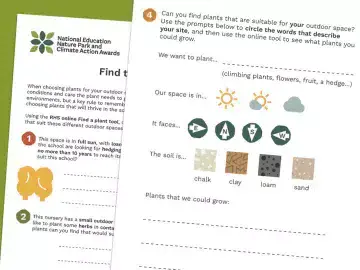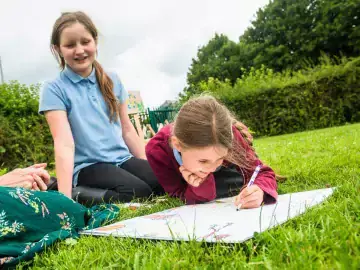
Life-size planning
Planning for physical change to your site can be quite daunting, but using props to represent features and objects can help you plan your outdoor space, and encourage children and young people to be imaginative and communicate their ideas. Using everyday objects or items you may already have on your site, this activity asks learners to create life-size models of what they want to implement to plan space and feasibility, and visualise their ideas.
This activity works well after completing the Ideas for improvement activity, to first explore solutions for your site.
Preparation
What you need
- A range of PE equipment or household items, for example: rope, flower pots, cones, sheets, bamboo cane or sticks, natural materials from your site, string or clothes pegs
Location
Outside
Useful guidance
Step by step
- First, decide on the location of a particular space you want to make your change – is there a focus area your group want to improve? Can you split into smaller groups and each work on a different area or solution?
- You are going to lay out on the ground suggested designs for your spaces so you will need items to do this with. To get a clear indication of how the design is going to work, the ideal scale to work on is 1:1, I.e. life-size. You can refer to our materials guidance for ideas on materials – these may include rope, flower pots, cones, bamboo cane or long sticks, netting or sheets, natural materials, and string or clothes pegs to secure items.
- This is an imaginative exercise! Help the group you are working with think about what each piece of equipment could represent – if marking out a path, perhaps rope or sticks make sense. If deciding where to place a pond, does a fabric or tarpaulin sheet visualise this best?
- If several groups are having a go, compare solutions at the end – ask each group to share what they have planned with their life-size objects.
- You may wish to vote on which design everyone likes best, or discuss the designs and take the best features of each to input into the final solution. Some evaluative questions can help children and young people understand if their ideas are suitable, for example:
- Does it fit in the space? Is it the right size?
- Is it safe to locate it here?
- Does it obscure or block anything?
- Does it look how you imagined?
- Does it work in the space?
Adapted from 'Learn and Play Out' by Learning through Landscapes.
Curriculum links
This activity can be used to support curriculum knowledge and skill development in maths, geography and design & technology, alongside enhancing nature education, with age and skill appropriate adaptations.
What to try next

Using overlays
Begin activity
Find that plant!
Begin activity
Planning your Project: A Nature Park Guide
Begin activityThumbnail image: © RHS, Credit: RHS / Edward Shaw